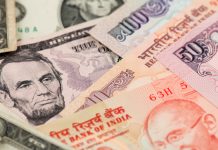- Indian Rupee (INR) rises for a 7th day
- Wholesale prices fall by 3.48%
- US Dollar (USD) falls ahead of the FOMC rate decision
- No change to the interest rate is expected
The US Dollar Indian Rupee (USD/INR) exchange rate is falling for a seventh straight session. The pair fell 0.2% in the previous session, settling on Tuesday at 82.22. At 11:30 UTC, USD/INR trades -0.18% at 82.44 and trades in a range of 82.07 to 82.32.
The Rupee is rising, capitalising on the weekend U.S. dollar as investors await the FOMC rate decision and despite wholesale inflation data.
Engine wholesale prices fell for a second straight month in May amid easing input costs and lower commodity prices. The wholesale price index fell by 3.48% in May, more than the 2.35% decline forecast and more than the 0.92% decline in April.
Delving deeper into the numbers, food prices fell by 1.59%, while fuel and power fell by 9.17%, and manufactured products dropped by 2.97%.
The data comes off the annual retail inflation also cooled to a more than two-year low of 4.25%, in May bringing it closer to the Reserve Bank of India’s 4% target.
The US Dollar is falling across the board. The US Dollar Index, which measures the greenback versus a basket of major currencies, trades -0.2% at the time of writing at 103.13.
The US dollar is falling as investors look ahead to the Federal Reserve interest rate meeting, which is due later today.
The meeting comes after US Inflation data yesterday showed that consumer prices cooled by more than expected to 4% year on year. This was down from 4.9% in April and fueled expectations that the Federal Reserve will leave interest rates unchanged in the June meeting.
However, it’s worth noting that core inflation only cooled slightly to 5.3% from 5.5%, meaning that the Federal Reserve will likely leave the door open for further rate hikes should they be needed.
In addition to the interest rates announcement, investors will be watching the latest economic projections, the dot plant, and the press conference with Federal Reserve to Jerome Powell closely in order to gain a better understanding of the path of future hikes.





